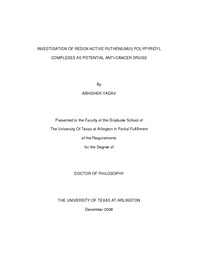| dc.description.abstract | Stereospecific binding of ruthenium metallointercalators with DNA is of particular interest because of the potential for improved targeting of specific sites in DNA. The present studies are focused on new metallointercalator, ruthenium (II) polypyridyl complex [(phen) 2 Ru(tatpp)(phen) 2 ]Cl 4 , [P p ] 4+ , and it's structural analog [Ru(phen) 2 (tatpp)]Cl 2 , [MP p ] 2+ ; the latter contains a redox active bridging ligand tatpp (where tatpp = 9,11,20,22-tetraazatetrapyrido[3,2-a:2',3'-c:3'',2''-l:2''',3'''-n]-pentacene and phen = 1,10-phenanthroline). Complex [P p ] 4+ exists as a mixture of ΔΔ-, ΔΔ- and ΔΔ- stereisomers whereas [MP p ] 2+ exists as a pair of enantiomers Δ- and Δ-. Previously our lab has shown promising cytotoxicity of these ruthenium(II) complexes against cancer cell lines (NSCLC). Also preliminary animal toxicity studies (mice) have shown these cationic complexes are well tolerated. These ruthenium(II) polypyridyl complexes target the DNA and bring about DNA damage under hypoxic conditions. The present studies are focused towards establishing a complete structure-activity relationship based on cytotoxicity and animal toxicity. The promising results in this screen led us to also study the antitumor activity of these ruthenium complexes in syngeneic mouse melanoma as well as lung cancer xenograft model. A novel free-radical based mechanism of DNA cleavage is proposed that is unique in that it is significantly more effective under hypoxic conditions. Chapter 2 discusses the studies aimed towards determining the mechanism of DNA cleavage of [P p ] 4+ and some related complexes. These studies support the role of a carbon-centered radical species in the cleavage mechanism as demonstrated by EPR and electrochemistry experiments. Chapter 3 describes the effects different structural parameters have on the cytotoxicity of these complexes against two non-small cell lung cancer cell lines (NSCLC- H358 and H226) and, in certain cases, against two normal, healthy cell lines, HUVEC and HAVSMC. The most antipromising activity was shown by complex with a longer bridging redox active ligand tatpp (ΔΔ-[P p ] 4+ and Δ-[MP p ] 2+ ) with an IC 50 value of about 10 μM, very rare for this class. In addition, the chapter also discusses the results from a NCI-60 panel prescreen of two promising complexes. These complexes were submitted to this free testing through the Developmental Therapeutics Program of the National Cancer Institute and the results are presented. Chapter 4 describes the toxicology and pharmacology of many of the ruthenium complexes studied in chapter 3. In the first experimental design, a murine structure-toxicity screen was performed on the more promising complexes from the cytotoxicity studies. Structural features leading to less toxicity were identified. The two chiral complexes ΔΔ-[P p ] 4+ and Δ-[MP p ] 2+ was shown to have low animal toxicity in the screen with MTD as high as 100 mg/Kg for both the complexes. The biodistribution of the rac/mix- ruthenium complexes [Ru p ] 2+ , [Z p ] 4+ and [P p ] 4+ were examined by sacrificing mice which had been given i.p. injections of these complexes at doses below the maximum tolerable dose. Mice were sacrificed at different times after dosing to follow the fates of the drugs temporally. Selected organs were collected by dissection and the ruthenium content analyzed using graphite furnace atomic absorption spectroscopy. It was found that the complexes were not accumulated in the organs and were mainly excreted. Chapter 5 examines the in-vivo anti-tumor activity of the most promising lead complexes identified in chapters 3 and 4. ΔΔ-[P p ] 4+ and Δ-[MP p ] 2+ were further examined for their ability to inhibit tumor growth in mice. Both complexes showed the ability to slow or stop tumor progression in both a syngeneic mouse melanoma model and in a xenograft human lung carcinoma model in nude mice. These striking results suggest these complexes have excellent potential for further development as anti-cancer drugs. | en_US |

